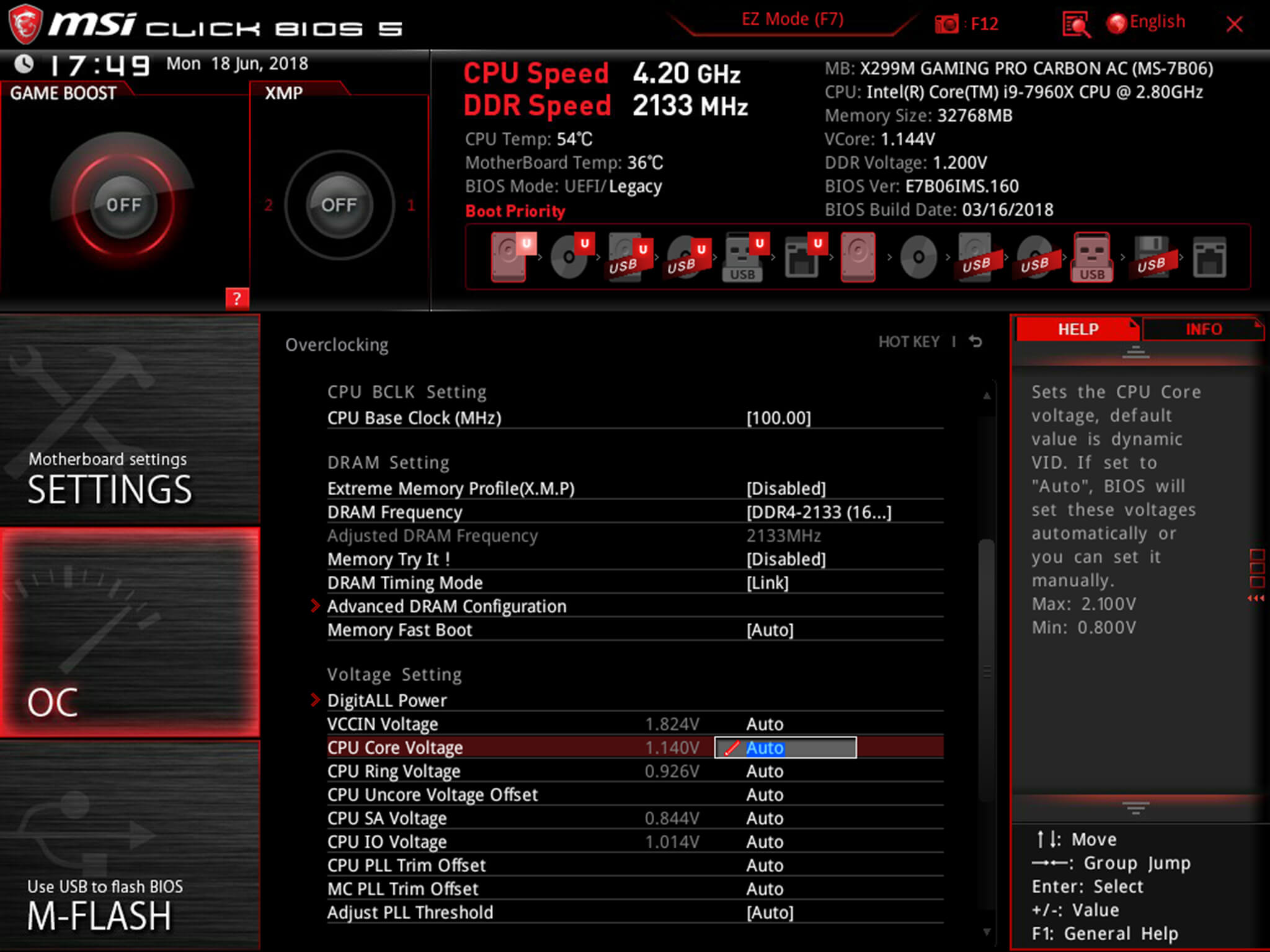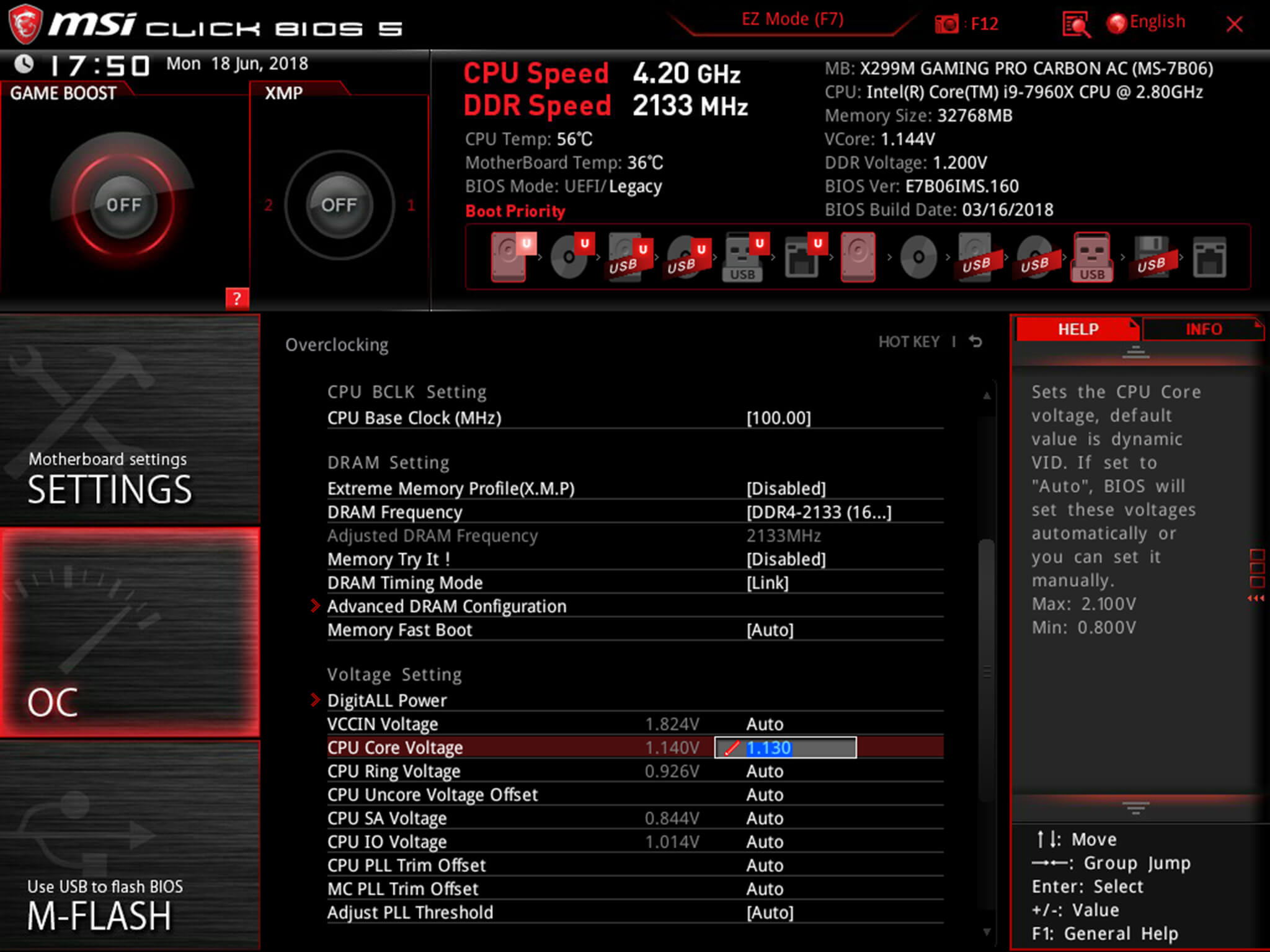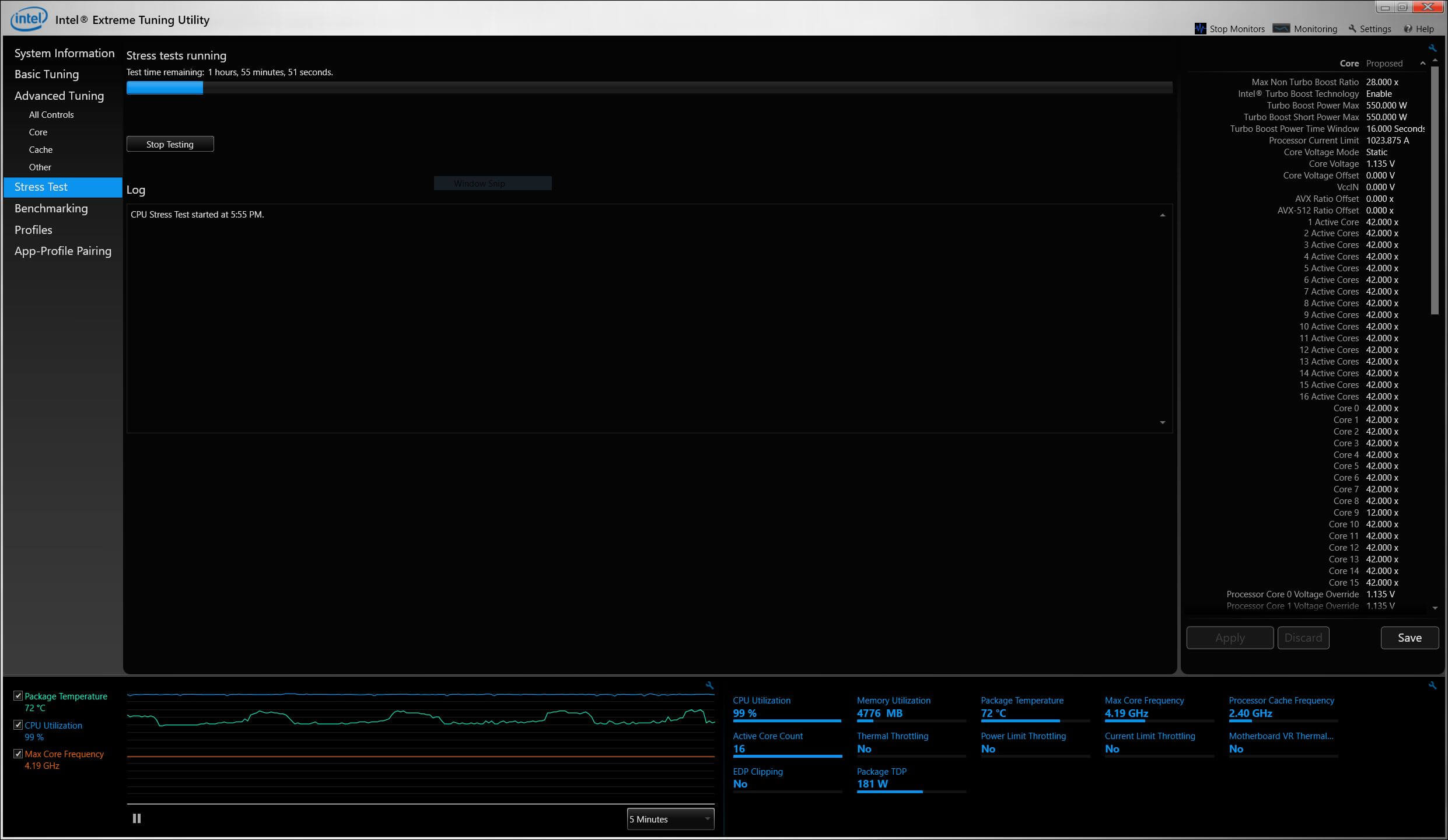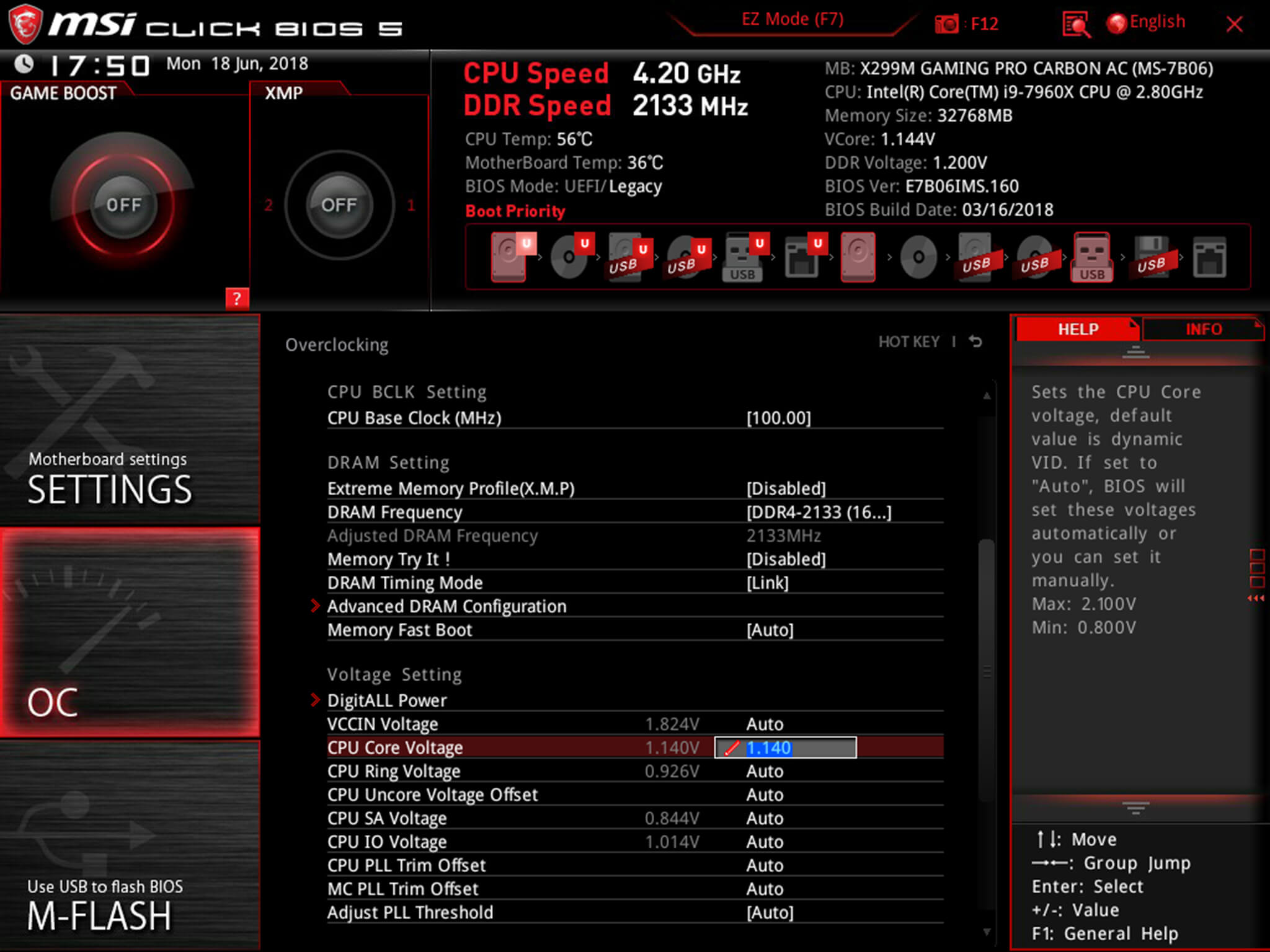The core voltage is different for each processor model, and while all CPUs of the same model have the same VID, not all samples maintain stability at the same clock speeds and Vcore due to slight variations in silicon quality. Every sample of the same CPU model is tested to maintain stability at the default speeds and the VID determined by the manufacturer.
Core voltage typically maintains a constant value while your CPU is in use; however, sometimes under heavy workloads vcore can fluctuate. This is known as Vdroop and can be corrected with load-line calibration. This applies additional voltage as load increases to maintain your CPU's stability.
When it comes to overclocking, you can only push your CPU's frequency so far before your CPU starts to experience instability. Programs might begin to crash or hang up, game performance could suffer or your computer could even fail to boot. This is because your processor isn't getting enough voltage to maintain system stability.
Increasing voltage will allow you to dial in the perfect overclock.
To adjust the voltage, you'll need to boot into your motherboard's BIOS and make adjustments there. The Vcore is expressed as a three decimal value, such as 1.235v. By default, the voltage control is set to auto; this can be overridden by typing in any value. Make sure not to exceed the recommended maximum for your processor.

Before fine-tuning the Vcore, it's important to find a good baseline value for a given speed. This varies from model to model but it can be helpful to read reviews for your CPU, specifically ones that focus on overclocking.
Most publications will list the voltage they required to keep several different speeds stable. Every CPU sample is different and you will need to fine-tune the voltage before calling it done; however, these values do provide a good starting point.

If you boot your machine and don't find any stability issues, then you know it's time to start decreasing the voltage. When overclocking, you want to find the lowest voltage required to maintain stability. More voltage equals more heat and this will allow you to keep temperatures under control.

The safest way to adjust voltage is with increments of .01 volts. Decrease voltage until your computer starts showing signs of instability under load. Use a program like Intel's Extreme Tuning Utility (XTU) or Prime95 to stress test your processor.
If the test fails or crashes, then you need to raise the voltage back up to the previous stable point. For optimal efficiency, you can increase the voltage by .005 instead and again test for stability.

Conversely, if your overclock isn't stable at your baseline voltage, you will then need to increase the voltage until your computer shows no adverse effects and then decrease in increments of .005 to fine tune.

Overclocking is not the only time it can be useful to adjust voltage. As mentioned, higher voltage levels cause your CPU to generate more heat, regardless of frequency. Some CPU samples may have a higher VID than is actually required at the default frequency. Undervolting your processor allows your to maintain stability while decreasing temperatures and extending the life of your processor.
It's a common misconception that disabling Turbo Boost is a more effective substitute for shedding heat. While this does result in decreased temperatures, it is not an alternative as the purpose of undervolting is to maintain the same level of performance while generating less heat. When making adjustments, the same principles apply here as with overclocking, decrease Vcore in increments of .01 and then fine tune with adjustments of .005.
 What cracked the Milky Way's giant cosmic bone? Scientists think they know.
What cracked the Milky Way's giant cosmic bone? Scientists think they know.
 HBO's ‘Mrs. Fletcher’ deserves your attention because of Kathryn Hahn
HBO's ‘Mrs. Fletcher’ deserves your attention because of Kathryn Hahn
 High school basketball team loses game in worst way possible
High school basketball team loses game in worst way possible
 Uber just lost its license to operate in London. Again.
Uber just lost its license to operate in London. Again.
 NYT Strands hints, answers for May 18
NYT Strands hints, answers for May 18
 Elon Musk’s Cybertruck is a weird FU to Tesla haters
Elon Musk’s Cybertruck is a weird FU to Tesla haters
 It's on: Tesla Cybertruck and Ford F
It's on: Tesla Cybertruck and Ford F
 Women are 'weaker, less intelligent' says Polish politician during pay gap debate
Women are 'weaker, less intelligent' says Polish politician during pay gap debate
 Google's Cloud Print service will shut down for good in 2020
Google's Cloud Print service will shut down for good in 2020
 Best robot vacuum deal: Eufy Omni C20 robot vacuum and mop at record
Best robot vacuum deal: Eufy Omni C20 robot vacuum and mop at record
 Take 50% off toasty outdoor apparel at Columbia Sportswear
Take 50% off toasty outdoor apparel at Columbia Sportswear
 News anchor gets trolled after sending a company
News anchor gets trolled after sending a company
 Denny's tweets pretty clever, internet
Denny's tweets pretty clever, internet
 The fat bears are already extremely fat
The fat bears are already extremely fat
 John Boyega admits it was his 'Star Wars' script that ended up on eBay
John Boyega admits it was his 'Star Wars' script that ended up on eBay
 Baby Yoda toys and other merchandise will arrive in time for Christmas
Baby Yoda toys and other merchandise will arrive in time for Christmas
 This year, I'm thankful for Chris Evans and his 'Knives Out' sweater
This year, I'm thankful for Chris Evans and his 'Knives Out' sweater
 A worthless juicer and a Gipper-branded server
A worthless juicer and a Gipper-branded server
 Company of software engineer held at JFK hits back on LinkedIn
Company of software engineer held at JFK hits back on LinkedIn
The Misanthrophy of R. S. ThomasHow Tumblr taught young women to codePimps & Nazi Cattle: A Translator’s Adventures in the DictionaryMeta Quest 3 is getting a new bodyColleen Moore’s Fairy Castle—And Her Lost “Flaming Youth”Staffage: A Word I Learned from John AshberyQR code Super Bowl ad for Coinbase was kind of brilliantThe Teddy Bears’ PicnicCourtesy Counts: A Story of Nail Clipping and the SubwayAir frying garlic is the simple hack you need to know for easy recipes and tasty dishesOnly Five Days Left to #ReadEverywhereStaff Picks: Aira, Ruscha, ReichlBonnet Books: Paperbacks for the Patriarchy?Remembering New York’s 1980s Hardcore SceneThe Hotel Is Haunted—But No One CaresThe Seagull Is Perhaps History’s Most Maligned BirdColleen Moore’s Fairy Castle—And Her Lost “Flaming Youth”Larry David's Super Bowl ad for FTX is dividing people6 of the best YouTube videos to fall asleep toThe Super Bowl halftime show had the internet feeling intense nostalgia, and feeling a little old Poets on Couches: Jake Skeets by The Paris Review CES 2024: 5 car trends we're expecting to see The Ancestry Project by Mariah Stovall The Untranslatable by The Paris Review Redux: Nor Staple Down to Fact by The Paris Review Inside Story: A Wrinkle in Time by Derek Palacio Public Domain Day 2024 list: 12+ books, movies and songs entering the public domain How an average Joe became 'The Holdovers' cheered scene NYT's The Mini crossword answers for January 3 Americana by Erica Dawson On Horseback by Nell Painter Ashes to Ashes, Eel to Eel by Patrik Svensson Poets on Couches: Saskia Hamilton by Saskia Hamilton The Land Empty, the World Empty by Jean Giono 4 major Samsung products rumored for 2024 Wordle today: The answer and hints for January 3 Staff Picks: Costa, Candles, and California by The Paris Review The Art of Distance No. 11 by The Paris Review NYT's The Mini crossword answers for January 2 Take an internet break this year
2.6775s , 10131.4609375 kb
Copyright © 2025 Powered by 【1988 Archives】,Prosperous Times Information Network